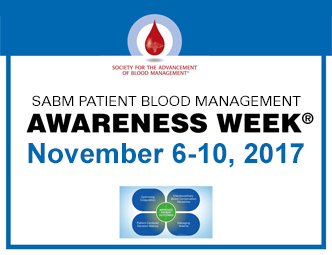SPRING 2017
ISSUE

The Society for the Advancement of Blood Management (SABM)
invites healthcare organizations worldwide to participate in this week dedicated to educating patients and healthcare professionals about patient blood management.
Download SABM's
Patient Blood Management Awareness Week 2017
Poster and Timeline
Please consider making a donation to your Society. Your donations will help us to improve the lives of people throughout the world through Patient Blood Management.

SABM 2017 Newsletter Publication Schedule
February | May | August | November
Editor
Carolyn Burns, MD
Associate Editor
Tiffany Hall, RN
Contributors
Arthur Bracey, MD
James Brown, MHA, CCP
Carolyn Burns, MD
Elizabeth Dackiw, RN
Nabil Hassan, MD
Tiffany Hall, RN
Becky Rock, RN
Kevin Wright
Meredith Reyes, MD
Ananthi Krishnamoorthy
Executive Director
Sherri Ozawa, RN
SABM Officers and
Directors
|
|
Breaking Clinical News
In this issue we feature three articles from SABM leaders that highlight the significance of PBM in the delivery of healthcare.
Patient Blood Management: An International Perspective
Eichbaum, Q. et al., Anesth Analg 2016;123:1574–81
At the AABB annual meeting in October 2014, experts from England, Uganda, China, and Brazil were invited to present on PBM programs in their countries as part of an education session on implementing PBM programs in international settings. To systematize the review and facilitate comparisons, authors addressed six key areas that included the greatest needs for developing PBM and collaborations to advance PBM practices.
The information shared by PBM experts from these countries with such diverse economic development levels highlighted important lessons: national level coordination is vital; the objectives and design of PBM programs need to be evidence-based; collaboration between countries and regions can enhance global adoption of PBM. Experiences from developed countries can be helpful to less developed countries to avoid various mistakes as their health care systems advance. Improvements in PBM can clearly also be bidirectional, and scientific innovations and clinical practices from developing countries may lead to global improvements in PBM.
Zika Virus and Patient Blood Management
Lawrence T. Goodnough, MD and Marisa B. Marques, MD Anesth Analg 2017;124:00–00
The Zika virus epidemic of the past year is the first example of a mosquito-borne infection associated with congenital malformations. This virus is an arthropod-borne virus (arbovirus), approximately 60% identical to the Japanese encephalitis virus, West Nile, and dengue virus at the nucleotide level. In the Americas, the virus was first identified in the state of Bahia (Brazil) in April of 2015 during an outbreak of the typical maculopapular rash. In February of 2016, the Centers for Disease Control and Prevention (CDC) announced that Zika infections had become notifiable conditions.
As a likely blood-transmissible pathogen, the conundrum for blood donor deferral strategies is that most individuals with Zika virus infection are asymptomatic. It is sobering to note that Zika, a current global threat as described by the World Health Organization, will inevitably be followed by future outbreaks of other bloodborne pathogens; the principles and practices of PBM will reduce the risks from not only known, but also unknown risks of blood transfusion for our patients.
Clinical Application of Prothrombin Complex Concentrate in Blood Management in Patients
Sherri Ozawa, RN and Tiffany Nelson, RN Critical Care Nurse. 2017;37[2]:49-56
Optimizing coagulation, a key factor for successful PBM, incorporates evidence-based rationale for the potential use of plasma or other blood components and fractions. Evaluating anticoagulant therapy is important as such drugs may need to be discontinued or rapidly reversed prior to urgent surgery or invasive procedures. Treatment with concentrated vitamin K, fresh frozen plasma, and/or clotting factors can achieve more rapid anticoagulant reversal than can drug discontinuation alone.
Fresh Frozen Plasma (FFP) is a blood product derived from plasma that contains all coagulation factors and fibrinogen. Traditionally, FFP has been considered the standard of care for urgent warfarin reversal even though randomized controlled trials have not indicated consistent evidence of its efficacy. Prothrombin Complex Concentrates (PCCs) are pooled plasma-derived products that contain a mixture of vitamin K–dependent proteins, such as factors II, IX, and X. Compared with FFP, PCCs contain 25 times the concentration of vitamin K–dependent clotting factors. To optimize both outcomes and utilization, decisions regarding product usage should include consideration of the clinical needs of the specific population of patients, current protocols for anticoagulant reversal, and product efficacy and cost; informed-consent policies should also be established.
Contributor: Kevin T. Wright
|
|
PBM for Patient Blood Management Section

Save the Date for SABM's Annual Meeting
September 6 – 9, 2017
Hilton & Executive Tower
Portland, Oregon
PBM Certificate Course
September 6, 2017
7:00am – 6:00pm
Annual Meeting
September 7 – 9, 2017

Consider submitting your future manuscripts in PBM for peer review and publication in this new section. The success of this endeavor will depend on the provision of material to make it lively and attractive to our colleagues and other professionals in the field.
Members Invited to Submit Papers CLICK HERE
Join SABM's Call to Action for Medicare to Expand Coverage for Treatment of Anemia!
Click HERE for detailed information about what you can do to get involved.
©2017 Society for the Advancement of Blood Management
350 Engle Street
Englewood, NJ 07631
Phone: (928) 551-6400
Fax: (877) 944-2272
EMAIL: [email protected]
|